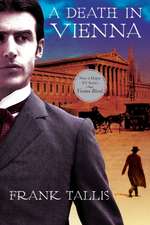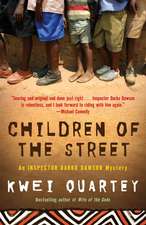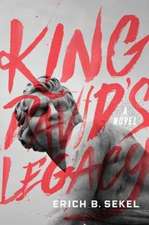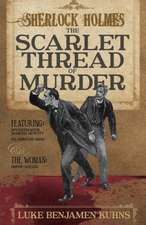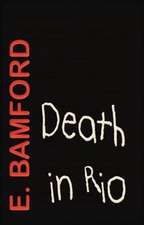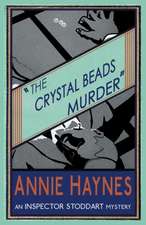Vienna Secrets: A Max Liebermann Mystery: Liebermann Papers (Paperback), cartea 04
Autor Frank Tallisen Limba Engleză Paperback – 31 ian 2010
Vezi toate premiile Carte premiată
Edgar Allan Poe Awards (2011), Anthony Awards (2011)
On opposite sides of the city, two men are found beheaded on church grounds. Detective Inspector Oskar Reinhardt is baffled. Could the killer be mentally ill, someone the victims came into contact with? Some are even blaming the murders on the devil. But when psychoanalyst Dr. Max Liebermann learns that both victims were vocal members of a shadowy anti-Semitic group, he turns his gaze to the city’s close-knit Hasidic community. The doctor is drawn into an urban underworld that hosts and hides virulent racists on one side and followers of kabbalah on the other. And as the evidence—and bodies—pile up, Liebermann must reconsider his own path, the one that led him away from the miraculous and toward a life of the mind.
Preț: 121.51 lei
Nou
Puncte Express: 182
Preț estimativ în valută:
23.25€ • 24.34$ • 19.29£
23.25€ • 24.34$ • 19.29£
Carte disponibilă
Livrare economică 20 martie-03 aprilie
Livrare express 05-11 martie pentru 66.39 lei
Preluare comenzi: 021 569.72.76
Specificații
ISBN-13: 9780812980998
ISBN-10: 0812980999
Pagini: 385
Dimensiuni: 141 x 201 x 22 mm
Greutate: 0.45 kg
Editura: Random House Trade
Seria Liebermann Papers (Paperback)
Locul publicării:New York, NY
ISBN-10: 0812980999
Pagini: 385
Dimensiuni: 141 x 201 x 22 mm
Greutate: 0.45 kg
Editura: Random House Trade
Seria Liebermann Papers (Paperback)
Locul publicării:New York, NY
Notă biografică
Frank Tallis is a writer and practicing clinical psychologist. He is the author of two previous Dr. Max Liebermann novels: Vienna Blood and Mortal Mischief.
Extras
Part One
The Breaking of the Vessels
Liebermann stepped down from the cab.
Two constables wearing long coats and spiked helmets were standing in the middle of the street, ready to block the passage of traffic. One of them came forward.
"Herr Dr. Liebermann?"
"Yes."
"This way, please."
The sun had barely risen, and the morning air was cold and dank. Ahead, four black lacquered carriages were parked: one of them was a windowless mortuary van. A flash of bright light unsettled the horses, signaling the presence of a police photographer. As Liebermann and his companion advanced, a cobbled concourse came into view, dominated by a white church with a convex baroque façade.
"Maria Treue Kirche," said the constable.
Liebermann had often passed the church on his way to the Josefstadt theatre, but he had never paused to appreciate its size. He had to tilt his head back to see it all. Two spires, each decorated with a girdle of globes, flanked a classical columned pediment. A gilt inscription declared Virgo Fidelis Ave Coelestis Mater Amoris, and below this was a clock face showing the early hour: six o'clock. Winged figures peered over the gable. They were disporting themselves beneath a gold crucifix, enhanced with radial spokes to represent rays of divine light.
On both sides of the concourse were identical three-story buildings. They were plain, functional structures, with roughcast walls. Liebermann saw the word "gymnasium" carved beneath a stone escutcheon.
In front of the church were two gas lamps, and around one of these a loose group of men had assembled. The photographer and his assistant were preparing to take another photograph. Again, there was a brilliant flash, which exposed something dark and shapeless on the ground. The smoke from the magnesium ribbon hung motionless in the air. Liebermann was dimly aware of clopping hooves and a nervous whinnying.
One of the men turned round, a portly gentleman with a well-waxed upturned mustache.
"Max!"
Detective Inspector Oskar Rheinhardt marched over to greet his friend. "Thank you for coming, Max."
The constable clicked his heels and hurried back to his post.
"When did you receive Haussmann's call?"
"About five," Liebermann replied, stifling a yawn.
"I'm sorry," said Rheinhardt, his eyes luminous with compunction. "I thought, as you do not live so very far away..." "Of course," said Liebermann, unable to disguise a note of reproach.
"What time must you be at the hospital?" "Seven-thirty."
Rheinhardt nodded and invited him to follow.
"Did Haussmann explain?" "Yes, he did." "You know what to expect, then. Good."
Grasping the photographer's arm, Rheinhardt said, "A moment, please." He then ushered his friend forward.
Within the circle of light around the gas lamp was what appeared at first to be a heap of clothes. It was situated within a large area of reflective blackness, the edges of which were irregular-like the borders of a country on a map. The air smelled faintly of rusting iron.
"Brother Stanislav," said Rheinhardt.
The monk's body appeared shapeless on account of the habit worn by the Piarist order. It was similar to that of the Jesuits-closed at the front, with three leather buttons. The corpse was supine, its feet hidden beneath the hem. A hand with curled fingers stuck out on one side. This pallid bony claw was the only visible part of Brother Stanislav. The cowl was sodden, flat, and unmistakably empty.
Liebermann looked beyond the body and located the monk's head. He had been forewarned, but this did little to mitigate the shock.
"He was discovered at about half past three," said Rheinhardt. "One of the Piarists-Brother Wendelin-could not sleep, and came out for some fresh air."
"Where is Brother Wendelin now?" asked Liebermann.
"In the church, praying."
"Did he see or hear anything?"
"Nothing at all."
Liebermann advanced, and made his way-somewhat warily-around the expanse of congealed blood. He squatted, and looked directly into the truncated stump of the monk's neck. The dawn sky provided him with just enough light to identify the remains of the key cervical structures; however, what he observed was nothing like the cross sections that he remembered from his anatomy classes, which had resembled the fatty marbled meat of a freshly sliced joint. The aperture of the trachea was displaced, as were the hardened remnants of cartilage. The vertebrae were fractured, and the muscles ripped and twisted. A rubbery length of artery hung out over the trapezius, still dripping. Something purple, veined, and lobulated was lying on the ground close to the monk's right shoulder. Liebermann guessed that it might be a piece of the thyroid gland.
A memory of his old anatomy professor's voice invaded Liebermann's mind: scalenus medius, sternocleidomastoid, omohyoid. The young doctor was perplexed. He was not a pathologist, but he knew enough anatomy to be deeply troubled by what he saw.
"What is it, Max?"
Liebermann waved his hand, indicating that he was not ready to comment. He stood up and moved toward the severed head. It seemed to take him an inordinate amount of time to travel the relatively short distance-and all the while the horrific object exercised a curious fascination. He could hear Rheinhardt following behind him and the sound of muted voices. The world seemed to recede.
Again, Liebermann bent down.
The dead monk's face was pressed against the cobbles, eyes closed, lips parted: hair and beard flecked with silver, pale skin maculated with spots of blood. His large aquiline nose was bent to one side. Even though Liebermann was all too aware that the object of his attention was insensate, he was suddenly seized by a powerful urge to reach out and rotate the head so that the monk would experience less discomfort. Years of adjusting the position of patients in their beds had made his concern instinctive, even, as now, in circumstances of unquestionable redundancy. Liebermann scrutinized the monk's neck and noted once more the same anatomical havoc: stretched and contorted musculature, identical displacements and splintering. The macabre skirt of papery skin was particularly disturbing. "Well?" said Rheinhardt. Liebermann stood up.
"It looks as if the head has been...torn from the body."
"That's what I thought. Perhaps I should go to the Prater this afternoon."
"I'm sorry?"
"To interview the strongmen."
The sound of a barrel organ: gentlemen in white body stockings and black trunks, tensing their arms to make their biceps bulge.
Liebermann couldn't imagine one of those vain, posturing clowns grasping the monk's head and ripping it from his shoulders.
"Oskar," said Liebermann. "Do you realize how much force is required to pull someone's head off?"
"Considerable force, obviously."
"Even with a horse-and some means of holding the body still-it would still be difficult." "Then it was several men?" "Perhaps..."
"How many?"
"Two or three heavy fellows sitting on the body, and a third and fourth to turn the head...but it would still have taken a while."
"How long?"
"It's difficult to say. But however long it might have taken, they don't seem to have been terribly concerned about being caught! They performed their heinous act under the gas lamp! Observe the pattern created by the flow of blood." The young doctor re-created the outpouring in the air with his hands. "Look at those splashes, which show us how the head rolled away from the body. Brother Stanislav was almost certainly decapitated as he lay on the ground in the very position we currently find him; however, he might not have been conscious when he was killed. His eyes are closed.... A man struggling against four or five assailants would almost certainly have had his eyes wide open when the spinal cord was severed."
"Couldn't the murderers have closed his eyes after the head was removed?"
"Well, they could. But it would be a strange thing to do, don't you think? Closing the eyes of the dead is usually a sign of respect."
The door of the church was unlatched, and an elderly monk appeared. He saw Rheinhardt and made his way over. "Father?" said Rheinhardt.
"My son, the children..." He looked exasperated. "Brother Stanislav's remains must be removed before the school opens. I'm afraid I cannot allow-"
"Our work is almost done," Rheinhardt interrupted. "It won't be long now, I promise you." He turned to Liebermann. "Excuse us." He then signed for the photographer to continue and steered the old monk back toward the church. In spite of the presence of so many men it was remarkably quiet. The police team spoke in hushed, reverential tones. On the other side of the road, facing the church, were some mansion blocks. Liebermann's view was partially obscured by a monument-a pillar of stone rising out of the concourse and surmounted by a statue of the Virgin Mary. It was as high as an Egyptian obelisk. He went to take a closer look.
At the base of the column were three large figures. The first of these held an open book and possessed an unusually compassionate face: head tilted forward, melancholy eyes, and creases suggesting depth of feeling. The figure wore robes of stone that had been masterfully sculpted into sensuous layers and folds. He or she-for the gender was ambiguous-wore a generous hood, beneath which hair flowed back in delicate waves. Liebermann admired the artistry that had gone into the figure's hands, which were delicate and beautifully poised. He noticed-with some regret-that one of the fingers had been broken.
Liebermann walked around the column and paused to consider the second figure. It too was hooded, but the hood enveloped a face invested with less sentiment: a long curly beard, staring eyes, and a somewhat vacant expression. Two birds, possibly doves, sat on a featureless slab held in the saint's left hand.
The third figure, a bearded man with no hood, was more interesting than the second. His gown billowed out, as if caught in a breeze. One of his arms was extended, and his posture suggested that he intended the passerby to look toward something from which he had averted his gaze. He rested a hand on his heart, an attitude that evoked sympathy.
This holy triumvirate was arranged around the pedestal of the column, on which a number of other figures of varying sizes (angels, cherubs, and knights) were mounted. The column itself rose to a great height and was decorated with a spiral motif of disembodied putti; however, their chubby little faces did not look happy. Indeed, the effect was quite sinister. It was as if the stone were sucking them in like quicksand.
On top of the column was a golden globe out of which projected two sharp horns, and on this ball of metal stood the Virgin. A ring of stars circled her head, and her hands were pressed together in prayer.
Liebermann took a step backward to get a better view and trod in what he thought at first was horse manure. He grimaced as he felt his foot sink into it; however, when he looked down, he saw that the cobbles were covered with scattered earth. He had to pick his way through the clods to avoid getting more on his shoes.
Rheinhardt had finished talking to the old monk and was now issuing instructions to the men standing beneath the gas lamp. The photographer lifted the camera off its tripod and placed it on the ground. There then followed a general dispersal. The inspector's assistant-Haussmann-ran over to the mortuary van and spoke to the driver. The van then turned a full circle in the street before mounting the pavement and rumbling onto the concourse. Some of the constables had to look lively to get out of its way.
"Well," Rheinhardt called as he approached, "what do you think?"
Liebermann grasped his chin, and tapped his pursed lips with his index finger.
"An anticlerical group?"
"Who?"
Liebermann shrugged.
"Or some former pupils, originally educated by Brother Stanislav, who returned to settle a score? A payback for some cruelty, some violation, perpetrated when they were powerless to retaliate."
"He was a priest!" said Rheinhardt, balking a little.
Liebermann threw his friend a look of wry amusement. He did not believe that an outward show of piety automatically merited respect.
"One should never underestimate the murderous rage of children. It is fierce, and unfettered by civilizing influences. I can well imagine some cherished infantile fantasy of revenge, shared by a close group of friends, festering, incubating in the unconscious, generating tension over many years-the release of which could then only ever be achieved by the performance of a brutal, cathartic murder. Ritualistic acts often focus and channel the energies of a community. They provide a means of safe discharge. Think, for example, of our funeral services and ceremonies. Appalling and otherwise unmanageable grief is contained by the time-honored practice of vigils, processing, and rites. There is certainly something ritualistic about decapitation. I wonder whether it served some similar purpose." Liebermann turned and faced the column. "What is this?"
"A plague monument, like the one on the Graben." "And who are these figures?"
They began to walk around the pedestal.
"This, I believe, is Saint Anna," said Rheinhardt, pointing to the androgynous figure with the compassionate face. "Mother of the Virgin. I don't know who the fellow with the two birds is supposed to be, but this one here"-Rheinhardt nodded at the final statue-"is almost certainly Saint Joseph, husband of the Virgin. Do you want me to find out who the fellow with the birds is?"
Before Liebermann could answer, he slipped on the cobbles. Rheinhardt caught his arm.
"Have you noticed all this mud?" exclaimed the young doctor. "It couldn't have been carried on people's shoes. There's too much of it. Is there a garden close by?"
"Not that I know of." Rheinhardt squatted down. "They might have arrived in a carriage..." The inspector squeezed some of the mud between his thumb and forefinger. "It could have been stuck to the wheels."
"In which case there should be wheel tracks. Can you see any?"
Rheinhardt studied the ground.
"Then perhaps it is inconsequential. Someone was carrying pots here earlier-and dropped them."
Liebermann scraped his feet on the iron railings surrounding the pedestal. The mud was sticky and not easily displaced.
"I can't attend a ward round with dirty shoes."
"No," said Rheinhardt. "That would be a catastrophe, I'm sure."
Liebermann ignored the inspector's pointed remark. Dirty shoes might not seem very important to Rheinhardt, especially when set against murder; however, in Vienna, a doctor indifferent to sartorial etiquette might just as well give up medicine. Liebermann took out a handkerchief, bent over, and started to polish. Rheinhardt raised his gaze to the sky. "What are you doing? There's a shoeblack who sets up a stall just outside the theatre. He'll be there in a few minutes!" Liebermann was not prepared to wait.
Chapter Two
Mendel Liebermann had not been very attentive during Professor Freud's lecture. The first part-a history of the scientific study of dreams-had been quite interesting, but the second part, which had dealt mainly with the professor's recent discoveries, seemed impenetrable. It wasn't the first time that Mendel had heard Freud talk at the B'nai B'rith lodge. Freud had addressed the brethren many times before, and when he wasn't talking about his psychological theories, Mendel found him perfectly intelligible, even entertaining. His talks on "The Goals and Purposes of the B'nai B'rith Order" and "The Role of Women in Our Union" were perceptive and thought-provoking; however, when Freud spoke about psychoanalysis, Mendel became utterly lost.
The Breaking of the Vessels
Liebermann stepped down from the cab.
Two constables wearing long coats and spiked helmets were standing in the middle of the street, ready to block the passage of traffic. One of them came forward.
"Herr Dr. Liebermann?"
"Yes."
"This way, please."
The sun had barely risen, and the morning air was cold and dank. Ahead, four black lacquered carriages were parked: one of them was a windowless mortuary van. A flash of bright light unsettled the horses, signaling the presence of a police photographer. As Liebermann and his companion advanced, a cobbled concourse came into view, dominated by a white church with a convex baroque façade.
"Maria Treue Kirche," said the constable.
Liebermann had often passed the church on his way to the Josefstadt theatre, but he had never paused to appreciate its size. He had to tilt his head back to see it all. Two spires, each decorated with a girdle of globes, flanked a classical columned pediment. A gilt inscription declared Virgo Fidelis Ave Coelestis Mater Amoris, and below this was a clock face showing the early hour: six o'clock. Winged figures peered over the gable. They were disporting themselves beneath a gold crucifix, enhanced with radial spokes to represent rays of divine light.
On both sides of the concourse were identical three-story buildings. They were plain, functional structures, with roughcast walls. Liebermann saw the word "gymnasium" carved beneath a stone escutcheon.
In front of the church were two gas lamps, and around one of these a loose group of men had assembled. The photographer and his assistant were preparing to take another photograph. Again, there was a brilliant flash, which exposed something dark and shapeless on the ground. The smoke from the magnesium ribbon hung motionless in the air. Liebermann was dimly aware of clopping hooves and a nervous whinnying.
One of the men turned round, a portly gentleman with a well-waxed upturned mustache.
"Max!"
Detective Inspector Oskar Rheinhardt marched over to greet his friend. "Thank you for coming, Max."
The constable clicked his heels and hurried back to his post.
"When did you receive Haussmann's call?"
"About five," Liebermann replied, stifling a yawn.
"I'm sorry," said Rheinhardt, his eyes luminous with compunction. "I thought, as you do not live so very far away..." "Of course," said Liebermann, unable to disguise a note of reproach.
"What time must you be at the hospital?" "Seven-thirty."
Rheinhardt nodded and invited him to follow.
"Did Haussmann explain?" "Yes, he did." "You know what to expect, then. Good."
Grasping the photographer's arm, Rheinhardt said, "A moment, please." He then ushered his friend forward.
Within the circle of light around the gas lamp was what appeared at first to be a heap of clothes. It was situated within a large area of reflective blackness, the edges of which were irregular-like the borders of a country on a map. The air smelled faintly of rusting iron.
"Brother Stanislav," said Rheinhardt.
The monk's body appeared shapeless on account of the habit worn by the Piarist order. It was similar to that of the Jesuits-closed at the front, with three leather buttons. The corpse was supine, its feet hidden beneath the hem. A hand with curled fingers stuck out on one side. This pallid bony claw was the only visible part of Brother Stanislav. The cowl was sodden, flat, and unmistakably empty.
Liebermann looked beyond the body and located the monk's head. He had been forewarned, but this did little to mitigate the shock.
"He was discovered at about half past three," said Rheinhardt. "One of the Piarists-Brother Wendelin-could not sleep, and came out for some fresh air."
"Where is Brother Wendelin now?" asked Liebermann.
"In the church, praying."
"Did he see or hear anything?"
"Nothing at all."
Liebermann advanced, and made his way-somewhat warily-around the expanse of congealed blood. He squatted, and looked directly into the truncated stump of the monk's neck. The dawn sky provided him with just enough light to identify the remains of the key cervical structures; however, what he observed was nothing like the cross sections that he remembered from his anatomy classes, which had resembled the fatty marbled meat of a freshly sliced joint. The aperture of the trachea was displaced, as were the hardened remnants of cartilage. The vertebrae were fractured, and the muscles ripped and twisted. A rubbery length of artery hung out over the trapezius, still dripping. Something purple, veined, and lobulated was lying on the ground close to the monk's right shoulder. Liebermann guessed that it might be a piece of the thyroid gland.
A memory of his old anatomy professor's voice invaded Liebermann's mind: scalenus medius, sternocleidomastoid, omohyoid. The young doctor was perplexed. He was not a pathologist, but he knew enough anatomy to be deeply troubled by what he saw.
"What is it, Max?"
Liebermann waved his hand, indicating that he was not ready to comment. He stood up and moved toward the severed head. It seemed to take him an inordinate amount of time to travel the relatively short distance-and all the while the horrific object exercised a curious fascination. He could hear Rheinhardt following behind him and the sound of muted voices. The world seemed to recede.
Again, Liebermann bent down.
The dead monk's face was pressed against the cobbles, eyes closed, lips parted: hair and beard flecked with silver, pale skin maculated with spots of blood. His large aquiline nose was bent to one side. Even though Liebermann was all too aware that the object of his attention was insensate, he was suddenly seized by a powerful urge to reach out and rotate the head so that the monk would experience less discomfort. Years of adjusting the position of patients in their beds had made his concern instinctive, even, as now, in circumstances of unquestionable redundancy. Liebermann scrutinized the monk's neck and noted once more the same anatomical havoc: stretched and contorted musculature, identical displacements and splintering. The macabre skirt of papery skin was particularly disturbing. "Well?" said Rheinhardt. Liebermann stood up.
"It looks as if the head has been...torn from the body."
"That's what I thought. Perhaps I should go to the Prater this afternoon."
"I'm sorry?"
"To interview the strongmen."
The sound of a barrel organ: gentlemen in white body stockings and black trunks, tensing their arms to make their biceps bulge.
Liebermann couldn't imagine one of those vain, posturing clowns grasping the monk's head and ripping it from his shoulders.
"Oskar," said Liebermann. "Do you realize how much force is required to pull someone's head off?"
"Considerable force, obviously."
"Even with a horse-and some means of holding the body still-it would still be difficult." "Then it was several men?" "Perhaps..."
"How many?"
"Two or three heavy fellows sitting on the body, and a third and fourth to turn the head...but it would still have taken a while."
"How long?"
"It's difficult to say. But however long it might have taken, they don't seem to have been terribly concerned about being caught! They performed their heinous act under the gas lamp! Observe the pattern created by the flow of blood." The young doctor re-created the outpouring in the air with his hands. "Look at those splashes, which show us how the head rolled away from the body. Brother Stanislav was almost certainly decapitated as he lay on the ground in the very position we currently find him; however, he might not have been conscious when he was killed. His eyes are closed.... A man struggling against four or five assailants would almost certainly have had his eyes wide open when the spinal cord was severed."
"Couldn't the murderers have closed his eyes after the head was removed?"
"Well, they could. But it would be a strange thing to do, don't you think? Closing the eyes of the dead is usually a sign of respect."
The door of the church was unlatched, and an elderly monk appeared. He saw Rheinhardt and made his way over. "Father?" said Rheinhardt.
"My son, the children..." He looked exasperated. "Brother Stanislav's remains must be removed before the school opens. I'm afraid I cannot allow-"
"Our work is almost done," Rheinhardt interrupted. "It won't be long now, I promise you." He turned to Liebermann. "Excuse us." He then signed for the photographer to continue and steered the old monk back toward the church. In spite of the presence of so many men it was remarkably quiet. The police team spoke in hushed, reverential tones. On the other side of the road, facing the church, were some mansion blocks. Liebermann's view was partially obscured by a monument-a pillar of stone rising out of the concourse and surmounted by a statue of the Virgin Mary. It was as high as an Egyptian obelisk. He went to take a closer look.
At the base of the column were three large figures. The first of these held an open book and possessed an unusually compassionate face: head tilted forward, melancholy eyes, and creases suggesting depth of feeling. The figure wore robes of stone that had been masterfully sculpted into sensuous layers and folds. He or she-for the gender was ambiguous-wore a generous hood, beneath which hair flowed back in delicate waves. Liebermann admired the artistry that had gone into the figure's hands, which were delicate and beautifully poised. He noticed-with some regret-that one of the fingers had been broken.
Liebermann walked around the column and paused to consider the second figure. It too was hooded, but the hood enveloped a face invested with less sentiment: a long curly beard, staring eyes, and a somewhat vacant expression. Two birds, possibly doves, sat on a featureless slab held in the saint's left hand.
The third figure, a bearded man with no hood, was more interesting than the second. His gown billowed out, as if caught in a breeze. One of his arms was extended, and his posture suggested that he intended the passerby to look toward something from which he had averted his gaze. He rested a hand on his heart, an attitude that evoked sympathy.
This holy triumvirate was arranged around the pedestal of the column, on which a number of other figures of varying sizes (angels, cherubs, and knights) were mounted. The column itself rose to a great height and was decorated with a spiral motif of disembodied putti; however, their chubby little faces did not look happy. Indeed, the effect was quite sinister. It was as if the stone were sucking them in like quicksand.
On top of the column was a golden globe out of which projected two sharp horns, and on this ball of metal stood the Virgin. A ring of stars circled her head, and her hands were pressed together in prayer.
Liebermann took a step backward to get a better view and trod in what he thought at first was horse manure. He grimaced as he felt his foot sink into it; however, when he looked down, he saw that the cobbles were covered with scattered earth. He had to pick his way through the clods to avoid getting more on his shoes.
Rheinhardt had finished talking to the old monk and was now issuing instructions to the men standing beneath the gas lamp. The photographer lifted the camera off its tripod and placed it on the ground. There then followed a general dispersal. The inspector's assistant-Haussmann-ran over to the mortuary van and spoke to the driver. The van then turned a full circle in the street before mounting the pavement and rumbling onto the concourse. Some of the constables had to look lively to get out of its way.
"Well," Rheinhardt called as he approached, "what do you think?"
Liebermann grasped his chin, and tapped his pursed lips with his index finger.
"An anticlerical group?"
"Who?"
Liebermann shrugged.
"Or some former pupils, originally educated by Brother Stanislav, who returned to settle a score? A payback for some cruelty, some violation, perpetrated when they were powerless to retaliate."
"He was a priest!" said Rheinhardt, balking a little.
Liebermann threw his friend a look of wry amusement. He did not believe that an outward show of piety automatically merited respect.
"One should never underestimate the murderous rage of children. It is fierce, and unfettered by civilizing influences. I can well imagine some cherished infantile fantasy of revenge, shared by a close group of friends, festering, incubating in the unconscious, generating tension over many years-the release of which could then only ever be achieved by the performance of a brutal, cathartic murder. Ritualistic acts often focus and channel the energies of a community. They provide a means of safe discharge. Think, for example, of our funeral services and ceremonies. Appalling and otherwise unmanageable grief is contained by the time-honored practice of vigils, processing, and rites. There is certainly something ritualistic about decapitation. I wonder whether it served some similar purpose." Liebermann turned and faced the column. "What is this?"
"A plague monument, like the one on the Graben." "And who are these figures?"
They began to walk around the pedestal.
"This, I believe, is Saint Anna," said Rheinhardt, pointing to the androgynous figure with the compassionate face. "Mother of the Virgin. I don't know who the fellow with the two birds is supposed to be, but this one here"-Rheinhardt nodded at the final statue-"is almost certainly Saint Joseph, husband of the Virgin. Do you want me to find out who the fellow with the birds is?"
Before Liebermann could answer, he slipped on the cobbles. Rheinhardt caught his arm.
"Have you noticed all this mud?" exclaimed the young doctor. "It couldn't have been carried on people's shoes. There's too much of it. Is there a garden close by?"
"Not that I know of." Rheinhardt squatted down. "They might have arrived in a carriage..." The inspector squeezed some of the mud between his thumb and forefinger. "It could have been stuck to the wheels."
"In which case there should be wheel tracks. Can you see any?"
Rheinhardt studied the ground.
"Then perhaps it is inconsequential. Someone was carrying pots here earlier-and dropped them."
Liebermann scraped his feet on the iron railings surrounding the pedestal. The mud was sticky and not easily displaced.
"I can't attend a ward round with dirty shoes."
"No," said Rheinhardt. "That would be a catastrophe, I'm sure."
Liebermann ignored the inspector's pointed remark. Dirty shoes might not seem very important to Rheinhardt, especially when set against murder; however, in Vienna, a doctor indifferent to sartorial etiquette might just as well give up medicine. Liebermann took out a handkerchief, bent over, and started to polish. Rheinhardt raised his gaze to the sky. "What are you doing? There's a shoeblack who sets up a stall just outside the theatre. He'll be there in a few minutes!" Liebermann was not prepared to wait.
Chapter Two
Mendel Liebermann had not been very attentive during Professor Freud's lecture. The first part-a history of the scientific study of dreams-had been quite interesting, but the second part, which had dealt mainly with the professor's recent discoveries, seemed impenetrable. It wasn't the first time that Mendel had heard Freud talk at the B'nai B'rith lodge. Freud had addressed the brethren many times before, and when he wasn't talking about his psychological theories, Mendel found him perfectly intelligible, even entertaining. His talks on "The Goals and Purposes of the B'nai B'rith Order" and "The Role of Women in Our Union" were perceptive and thought-provoking; however, when Freud spoke about psychoanalysis, Mendel became utterly lost.
Recenzii
“A strong, intelligent plot and a terrific atmosphere of fin-de-siècle Vienna.”—The Times, London
"Tallis's excellent fourth puzzler set in early 20th-century Vienna (after 2008's Fatal Lies) neatly blends mystery and history...Fans of Caleb Carr will feel right at home." —Publisher's Weekly, starred review
"The historical details of police work and forensic investigation again are a strong point, and with this book’s inclusion of a trip to Prague, readers are introduced to another fascinating city...A solid entry in an excellent historical mystery series." —Booklist
"Captivating...[an] elegantly designed and executed period mystery." ߝNew York Times Book Review
"Tallis's excellent fourth puzzler set in early 20th-century Vienna (after 2008's Fatal Lies) neatly blends mystery and history...Fans of Caleb Carr will feel right at home." —Publisher's Weekly, starred review
"The historical details of police work and forensic investigation again are a strong point, and with this book’s inclusion of a trip to Prague, readers are introduced to another fascinating city...A solid entry in an excellent historical mystery series." —Booklist
"Captivating...[an] elegantly designed and executed period mystery." ߝNew York Times Book Review
Descriere
In the dangerous, dazzling Vienna of 1903, an ingenious doctor and an intrepid detective again challenge psychotic criminals across a landscape teetering between the sophisticated and the savage, the thrilling future and the primitive past.
Premii
- Edgar Allan Poe Awards Nominee, 2011
- Anthony Awards Nominee, 2011


